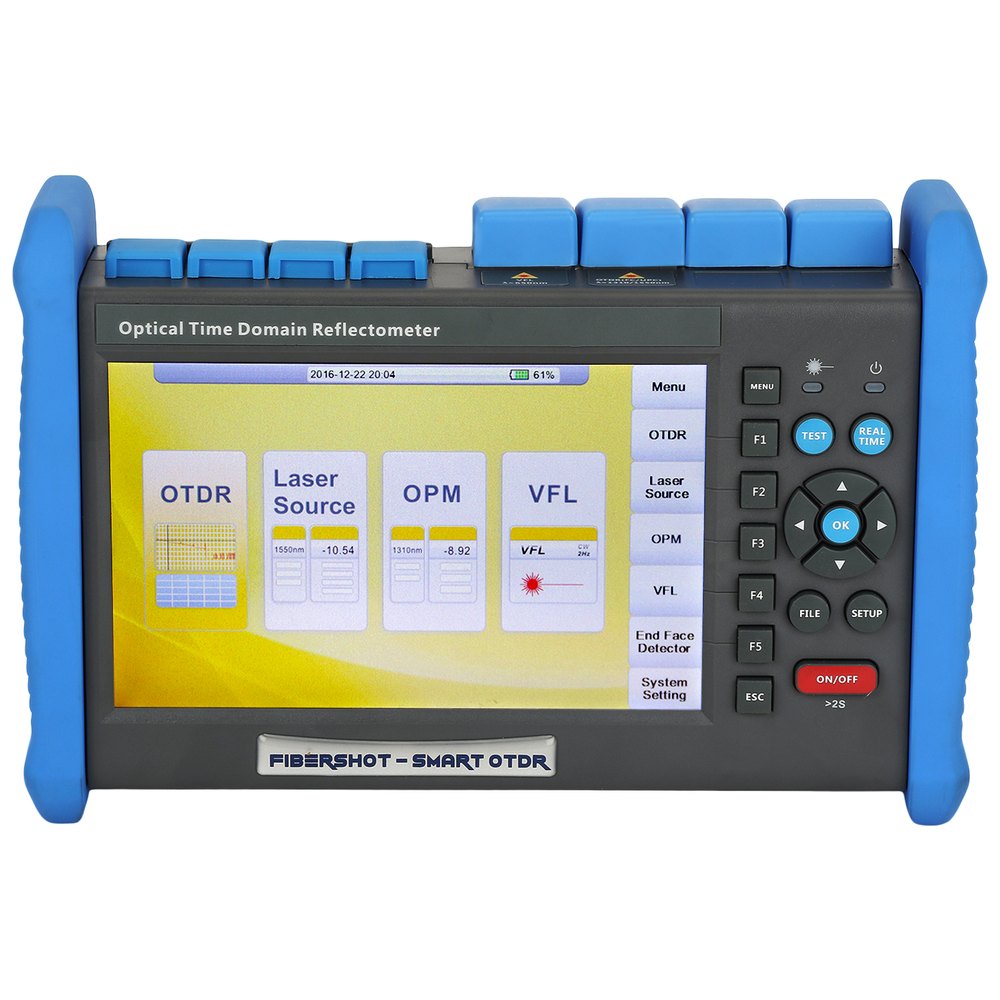OTDR testing uses high power light pulses to measure backscatter caused by small defects in the glass that make up an optical fiber. This reflected light is then plotted in a "trace" on the OTDR display screen over time.
There are many factors that affect the accuracy of an OTDR trace, such as attenuation, reflection, loss, and noise. The goal is to get a trace that will give the technician the best picture of the fiber under test.
Attenuation
In electrical communication systems, attenuation refers to the loss of an electrical signal's power level as it travels through a transmission line. This loss is measured in decibels (dB) to indicate the overall amount of loss. Attenuation also depends on the type of cable and the impedance of the cable.
OTDRs use high-power light pulses to send down fibers, which are then reflected by the fiber’s internal structure and small defects. This scattering occurs in the form of Rayleigh backscatter. OTDRs are sensitive to this backscatter by measuring the amount of light reflected from each pulse.
This backscatter measurement is then plotted on an OTDR trace that shows reflected and backscattered light versus distance along the fiber. This trace is usually a curve that slopes downward and may be interrupted by gradual shifts or losses. Loss events appear as a point defect or sharp change in the tracing pattern.
If you are analyzing an OTDR trace, it is important to be familiar with what the curve looks like and how to interpret it. The Y-axis of the trace represents the incoming power while the X-axis shows the distance.
A good trace should show a gradual decline, sloping down the Y-axis to an eventual large spike at the end of the fiber. The end of the trace indicates a significant loss event that may be spliced or connector related.
In order to get the highest range that your OTDR can provide, you will want to set the instrument for the longest possible pulse width that allows light to travel the length of the fiber and return to the OTDR at a high amplitude. You will also need to adjust the averaging time to reduce background noise.
For example, a shortest pulsewidth of 10ns would provide a pulse length of 2m in the fiber, and the range discrimination would be half that. This allows the Palm OTDR to display two events separated by 1m as separate events and therefore cover a greater range of distance than an attenuation test.
Attenuation dead zones (ADZ) are caused by reflections from the connector that reduce the signal's amplitude. These dead zones can be caused by several reasons, including dirt on the connector surface or a dirty connector adapter. In these cases, it is important to clean both the connector and the adapter thoroughly before and during testing.
Reflection
Reflection is a process that occurs when light travels through a surface, such as a mirror or polished metal, and then bounces back off the surface. According to particle theory, this reflection process is very similar to waves; however, a reflection does not involve the order of the particles (photons) being reversed like waves do. Instead, photons are scattered into a stream of tiny particles (elements) that then bounce back off the surface.
For testing, the OTDR sends out a high power pulse of light and measures the amount of light that comes back to the instrument over time as it passes through the fiber. This light is then correlated with an actual location in the fiber to create a trace.
The OTDR is sensitive to the amount of backscatter it sees, so it is very important that you find a relatively long section of fiber for testing. The longer the distance, the more accurate your measurement will be.
It is also a good idea to avoid events such as connectors and mechanical splices, since these can take some time for the OTDR to get a reading. These events can cause a non-linearity in the trace that can result in erroneous measurements.
Once the OTDR has made a measurement, it will display the time-based plot that shows how much of the signal is attenuated or reflected. This is called the optical return loss (ORL) and can be used to identify defects that may have caused loss in a fiber cable.
As with all backscatter measurements, the Mini OTDR has a high measurement uncertainty. This is because the OTDR is not measuring the exact amount of backscatter that is coming through the fiber, but the overall level and power in the reflected peak.
When testing for reflection, the OTDR is usually adjusted to a certain pulse width so that it can see events in different parts of the cable plant. Adjusting the pulse width increases the number of backscatter events that the OTDR can see, but at the expense of resolution between these events. The test pulse can overload the OTDR, which reduces its ability to see events close by.

image source https://www.pinterest.ph/
Loss
OTDR testing measures loss indirectly by looking for "backscattered" light and reflected light from connectors, cleaved fiber ends and sharp bends. This unique optical phenomenon is one of the main sources of error when measuring fiber length and loss.
The OTDR works like a RADAR, sending pulses down the fiber and looking for return signals from fiber backscatter and reflections from joints. These return signals create a display called a "trace" or "signature." From this trace, the OTDR determines fiber length, attenuation and joint loss.
An OTDR trace shows a gradual decline in the power of the test pulse as it travels along the fiber. It may also be interrupted by sudden shifts that represent deviations of the trace downward or upward, often indicating connections, splices and breaks in the fiber. The end of the fiber may be identified by a large spike in the trace that drops dramatically down the Y-axis.
However, OTDR traces can be difficult to interpret at times because of how they are designed and how the OTDR operates. This is particularly true of long fibers or fiber systems with a large number of splices. The accuracy of a fiber trace can be greatly reduced when the OTDR operator is not well trained and experienced in interpreting OTDR traces.
Because of this, it is important to use a qualified technician who has a thorough understanding of how OTDRs work. This person must have extensive experience with fiber cabling infrastructure, be able to name and identify the end of the test cable used and know what to look for in an OTDR trace.
Loss in an OTDR is measured by calculating the total of all the light reflected from reflective events plus the total of the backscatter from the entire length of fiber being tested. This measurement is sometimes called "optical return loss" or ORL for short.
The loss value shown by an 7 inch multifunction OTDR is usually a negative figure. This is a result of the OTDR using least squares averaging to reduce the noise effects that can occur during testing.

image source https://www.pinterest.ph/
Noise
The OTDR is the most critical piece of equipment for obtaining complete end-to-end link validation by testing for macro bends, breaks and other potential faults that could affect network performance. Unlike sources and power meters that directly measure loss, the OTDR uses a unique optical phenomenon called backscatter to create a fiber trace with reflected light.
OTDRs use a high-power laser or fiber optic light source to send pulses of light through the fiber. The light reflects off the fiber surface and then travels back to the instrument where it is collected. This information is then averaged to generate a OTDR trace.
A lot of the error in OTDR measurements comes from the number and length of reflections. The longer the distance between events, the higher the level of noise in the OTDR trace will be. This can be a serious problem in long-distance tests.
One way to avoid this is to set up your OTDR so that each event is measured in its own separate segment. This is known as least squares averaging (LSA), and requires setting several markers, one on the peak, two regular markers near the event and two end markers to define the segments used for LSA.
When you do this, you need to remember that the markers have to be placed on sections of the fiber where the trace is straight. If they are not, the loss will be affected by the shape of the splice or connector and you may get an inaccurate measurement.
Another option for getting more accurate loss measurements is to change the pulse width of the test pulse. Adjusting the pulse width will make the backscatter signal larger, but it also decreases resolution between events. This makes OTDR testing less sensitive to small changes in the cable plant that might occur during the test, and increases the probability of erroneous events.
To reduce the amount of noise in your OTDR trace, it is a good idea to adjust the OTDR pulse width as you would any other test method. This will not only improve the level of accuracy in your OTDR results but will help minimize the effect of settling time caused by connectors, splices and other reflective events. It is also a good practice to compare traces taken using different test methods on the same fiber. This will allow you to see which test method produces the cleanest traces.


No comments yet